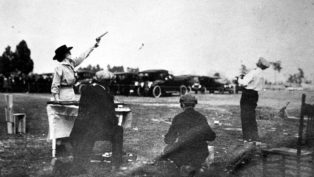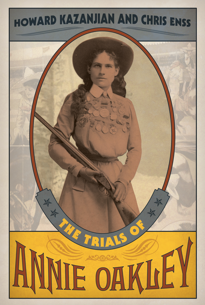Enter now for a chance to win a copy of
The Trials of Annie Oakley.

A row of ten, smartly dressed women stood side by side carefully scanning the horizon. Each was holding a rifle and waiting patiently for the instructor to give her directions. A genteel, smiling Annie Oakley stepped forward carrying her own weapon. A handful of ladies who had arranged to take shooting lessons from the famous markswoman stood near the side entrance of the firearms school in Pinehurst, North Carolina, anxiously awaiting the opportunity to draw a bead on a target and fire their guns.
Shooting at clay targets a few inches wide as they flew past at fast speed and actually hitting them was a thrill like none other. Annie had assured her students of that fact. Trap shooting involved speed, accuracy, and eye-hand coordination, something Annie had in abundance. For years she had extolled the virtues of trapshooting and was proof it could be done for pure enjoyment or competition. She reminded her class to keep both eyes opened, be aware of the position of their bodies while holding their .22- caliber shotguns, keep their cheek glued to the stock, point, and shoot.
KaBang! Kabang! Kabang! The weapons rang out in succession. The women were thrilled that their guns fired without incident and were excited to try again. Annie had warned them the sport could be addictive once they took the plunge.
From the time the United States entered World War I in early 1917 to November 1918, Annie had instructed more than 4,000 men and women on how to shoot. For many women, the time learning how to use a firearm led to regular participation in the sport of trapshooting. For many men the instruction helped them prepare for battle. Annie’s desire to serve her country in combat was realized through the soldiers who admired how she used a gun and employed what she taught in battle.
The Great War ended at the eleventh hour on the eleventh day of the eleventh month of 1918. Annie Oakley was fifty-eight years old. Although she had appeared in numerous exhibitions at cantonments throughout the east and demonstrated her skill to thousands of recruits bound for Europe to fight, many people wrote letters to the author of a syndicated column called “Trap, Gun and Rod,” hoping to find out what became of the once popular markswoman. “Is she still living,” a reader in Pittsburg, Pennsylvania, asked? “If so, how old would she be?”
“Annie Oakley (Mrs. Frank Butler) is very much alive and very much active in shooting game,” responded reporter Tom Marshall. “The last time I saw her shoot she performed with the old time vim and accuracy.”
If Annie had ever forgotten her age, newspapers across the country reminded her. An article that appeared in the January 3, 1919, Wilmington, Delaware, newspaper The Morning News told of an occasion where Annie’s age was the topic of conversation. It was a gathering of New York sportswriters. After much speculation, the writers were unable to agree on how old the sharpshooter was and couldn’t guess what the future held for the talented woman. The author of The Morning News article decided to take the questions to the source.
Annie was not ashamed to admit her age or to share her future plans. “On my sixtieth birthday next November, I will make my farewell appearance before the American public in an exhibition of shooting with the revolver, rifle, and shotgun,” she informed the reporter. “The exhibition will be in New York. When I begin to make plans for this shoot you will know that I am nearing the three-score of year’s mark – also that it will be the final appearance of Annie Oakley in public as a shooter.”

To learn more about the famous sure shot read
The Trials of Annie Oakley.

